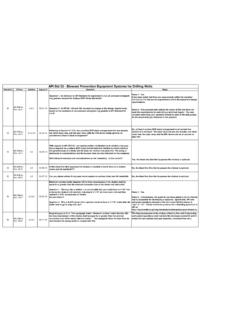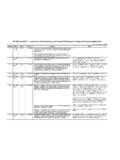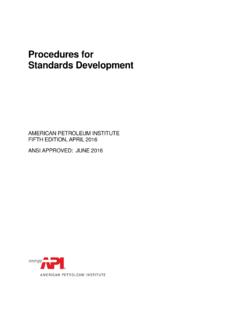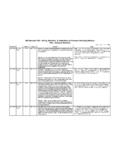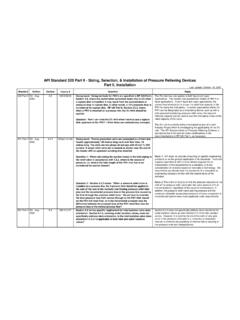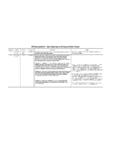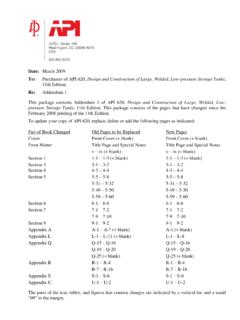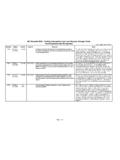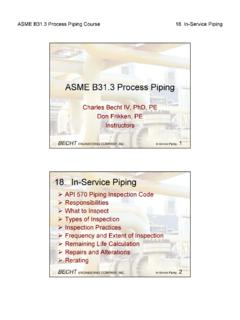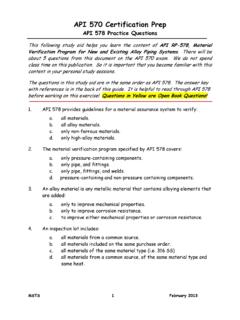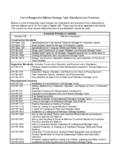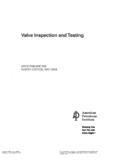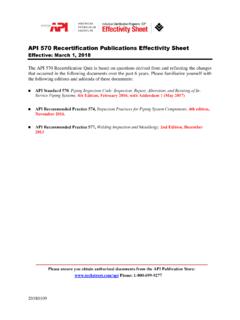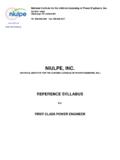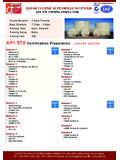Transcription of API 570 - Piping Inspection Code
1 StandardEditionSectionInquiry #QuestionReply5702nd Edition, Oct. 19983570-I-02/03 Background: Section defines Piping Engineer , but the term corrosion engineer or corrosion expert is used in several places in the : Does the term Piping engineer include the concept of corrosion engineer?The term Piping engineer is not defined in API 570. The committee has taken an action to establish a definition for this term. Any changes to the code resulting from this action will appear in a future addendum or edition of API Edition, Oct. : Sections , , and (k) appear to reference (or require) that non-destructive examinations be carried out to the original construction code ( , ASME ).
2 The code requires that ultrasonic procedures conform to ASME Section V, Article 5. This article has recently been substantially revised (in 2002) to simply reference SE-797 for UT thickness requirements unless amended otherwise in this Article .Question 1: Is it the intent of the noted sections that UT thickness written procedures conforming to SE-797 should be utilized when conducting in-service thickness examinations for corrosion monitoring purposes?Question 2: If the answer to Question 1 is no , is it the intent of the noted sections that UT thickness written procedures conforming to Table T-522 of ASME Section V, Article 5 in the 2002 Addenda, should be utilized when conducting in-service thickness examinations for corrosion monitoring purposes?
3 Question 3: If the answer to Question 1 is no , what procedural requirements should be followed to meet the intent of the code ?Reply 1: 2: 3: Procedural requirements for ultrasonic thickness measurements are not addressed in API Edition, Oct. : Section states "TMLs may be eliminated ..under certain circumstances, such noncorrosive hydrocarbon product ..". Additionally, states "TMLs can be eliminated for Piping systems with either of the following two charcateristics: .. b. Noncorrosive systems, as demonstrated by history or similar service .."Question: Can these sentences be interpreted to mean that no TMLs need ever be established during the lifetime of a Piping system?
4 In accordance with , the owner/user should consult with persons knowledgeable in corrosion when substantially reducing or eliminating TMLs. This issue has been assigned to the API Subcommittee on Inspection for consideration in future editions of the Edition, Oct. should the rings for RTJ flanges be replaced?API 570 does not specify when RTJ gaskets should be replaced. The committee will consider adding guidance on this topic in RP 574, Inspection Practices for Piping System 570 - Piping Inspection CodeLast update: June 28 2007 Page 1 of 8 StandardEditionSectionInquiry #QuestionReplyAPI 570 - Piping Inspection CodeLast update: June 28 2007 5702nd Edition, Oct.
5 : The purpose of this letter is to request an interpretation of the term flammable used in Section describing Class 3 Piping service. Flammable is not included in the Section 3 definitions. From the descriptions in Sections through , the Piping Inspection program is intended to apply to services where the potential for explosion, fire, toxicity, or environmental impact exist in the case of leakage from the Piping service. The sentence in question defines Class 3 Piping service as Services that are flammable but do not significantly vaporize when they leak and are not located in high-activity areas are in Class 3.
6 The potential for explosion, fire, toxicity, environmental, or other potential effects from leakage from this Piping is very 1: Could Piping within an oil terminal containing oil-related liquid that is not flammable by NFPA 30 or DOT classifications be included in Class 3?Question 2: Would it be included in Class 2?Reply 1: Section states that owner/users shall maintain a record of process Piping fluids handled, including their classifications. It also provides guidance on reference documents and provides recommended classes. It is the responsibility of the owner/user to define what is applicable and what specific definitions he/she 2: See Reply Edition, Oct.
7 It acceptable to use specifically trained personnel who are not certified to API 570 to perform visual external Inspection and be in compliance with API 570, Section Such a role is defined as an examiner in Section Edition, Oct. nominal pipe wall thickness for Table 6-1 be used as the initial thickness for determining the Inspection frequencies and retirement date and still meet the intent of API 570 and OSHA Process Safety Management, and would this involve additional requirements?API can only provide interpretations on requirements stated in API standards.
8 The second edition of API 570, including Addenda 1 and 2, provides options for initial determination of corrosion rates and allows for the owner/user s experience. In past editions specific guidance did indicate that the use initially of published nominal wall thickness could be used in the absence of any other information. It is recognized that an owner/user may choose this approach until improved information is Edition, Oct. a Piping leak is observed and operations has the ability to isolate the system for a very brief period of time, can a temporary repair ( patch, full enclosure) be implemented?
9 API 570 does not restrict whether or not a temporary repair can be performed, even if the Piping system can be temporarily taken out of service. This is a decision that can be made by the owner/user with prior consultation with a Piping engineer and the authorized Piping Edition, Oct. it allowed to use a full encirclement welded split sleeve as a permanent repair ? Section specifies this type of repair as temporary . Under which conditions is this permitted?The conditions under which a temporary repair may remain for an extended period, upon approval of a Piping engineer, are explained in 2 of 8 StandardEditionSectionInquiry #QuestionReplyAPI 570 - Piping Inspection CodeLast update: June 28 2007 5702nd Edition, Oct.
10 To ;Question 1: Is it acceptable in to have a lap patch near or at a structural discontinuity such as a support saddle?Question 2: Is it acceptable to have a lap patch cross over a weld seam? If not, what is the minimum distance permitted?Question 3: Is it acceptable to have a lap patch cross over another lap patch? If not, what is the minimum distance permitted?Reply 1: 2: 3: Edition, Oct. the use of a full-encirclement split tee considered a temporary repair as defined by per API 570?The use of any type of full-encirclement, split fitting (tee or sleeve) is considered temporary per API 570 if it used in the context of a repair ( repair locally thinned area).
